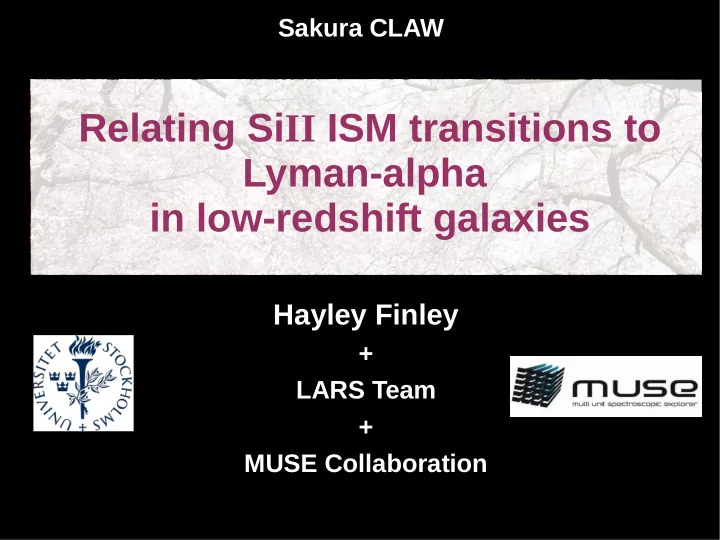

Sakura CLAW Relating Si II ISM transitions to Lyman-alpha in low-redshift galaxies Hayley Finley + LARS Team + MUSE Collaboration
Lyα as a probe of the CGM ↔ CGM as a probe of Lyα
How do outflows contribute to Lyα escape ? ● H I column density ● Dust ● Geometry
FeII* emission
SiII* emission
Galactic outflows in emission MUSE [O II ] emitter z ~ 1.29 Finley et al. 2017a
FeII* emission is extended R 1/2 is 70 % larger than for the stellar continuum, [OII] emission Surface Brightness Finley et al. 2017a
Emission signatures vary along MS MUSE UDF 270 [O II ] emitters 0.85 < z < 1.5
Emission signatures vary along MS More gas, more dust
Mg II escape fraction Mg II escape follows dust attenuation Not much resonant scattering Highest optical depth lowest Calzetti et al (2000) attenuation Mg II fesc, like Lyα Feltre et al. 2018, in prep.
Mg II escape + Lyα escape Henry et al. 2018 10 Green Peas z ~ 0.2 – 0.3 HST COS Lyα and Mg II are both resonant lines similar impact from scattering
Does non-resonant emission (SiII*, FeII*) trace Lyα escape ?
Fitting SiII & SiII* LARS + GPs + LAEs
SiII* emission + Lyα escape LARS 1 – 14
Si II * vs Si II in LARS 14 Fesc = 0.16 Rivera-Thorsen et al. 2015 Henry et al. 2018
SiII emission + Lyα properties Chisholm et al. 2017
Outflow Models RASCAS Scarlata & Panagia 2015 outflow models T. Garel J. Blaizot L. Michel-Dansac A. Verhamme Impact of – geometry – dust – velocity & density profiles on resonant absorption + non-resonant emission
Conclusions and Future Prospects ● Trace galactic outflows from Fe II *, Si II *, C II * – Reach z ~ 3 with MUSE ● Combine observations and models to constrain geometry, dust content, N(H I ) ● Do the physical conditions that favor detecting non-resonant emission also favor Ly α escape ? Thank you !
Recommend
More recommend